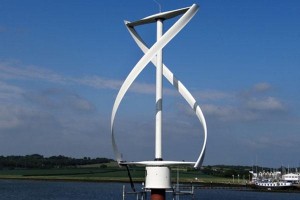
Image Credit X-Wind Power
Can you imagine trains powered by the wind? No, we’re not talking about putting sails on a train. Thanks to the new XW-80 turbine, it looks like Britain might be able to get 70% of the electricity it needs to power its railways straight from the sky. The project still has to go through a trial, but if it suceeds, the sheer fuel efficiency of the turbines will have a massive impact on the current way we look at energy.
Why a Vertical Turbine is the Solution
Currently, a large amount of wind-based energy comes from wind farms. Picture rows upon rows of classic-looking windmills, hooked up to a power generator. While this works great for powering nearby buildings, it doesn’t work quite as well when you want to power miles upon miles of train tracks.
Vertical turbines don’t need to be placed in a wind farm. They’re surprisingly quiet, and don’t take up nearly as much space. Instead of filling a farm with dozens of turbines, you could easily lay those turbines right next to the train tracks, providing power to the train as it travels.
Another advantage to vertical turbines is that they can handle an abrupt changes in wind direction. Horizontal turbines typically have a long response time when the wind changes, which can cause a loss of power. In an urban setting with unreliable wind, vertical turbines can fit in far more easily.
Will Vertical Turbines Become Part of the Urban Skyline?
Vertical turbines aren’t just good for train tracks. Their sleek design allows vertical turbines to be easily slipped into unused spaces, including the middle of cities. The shape of the turbines won’t block windows like a horizontal layout would, and isn’t as likely to interfere with communication signals.
These turbines are also quiet. It’s one thing to put a noisy, creaky horizontal turbine in the middle of the city, where any nearby homeowners will complain; it’s another to give them a quiet source of cheap energy that adds far more to the community than it takes away.
Of course, there won’t be a turbine in every city. Some places just don’t have enough wind to generate a useful amount of electricity. But cities with ever-present breezes would make a great target for this form of technology. If the wind is there and you can fit the turbines around pre-exisiting buildings, why not try it out?
The XW-80 still needs to be tested out. But if Britain successfully manages to power their rails with the wind, we’re looking at a huge change in both the fuel and transportation industries. Public transportation is already fairly cheap compared to regular vehicles. Make it more energy efficient and reduce the cost on the city, and you might be seeing a wind-powered train in your own city within a few decades.

Comments are closed